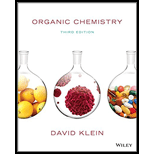
(a)
Interpretation: For the given compounds, major products should be predicted when each of them are treated with Birch condition.
Concept introduction:
- Birch reduction converts
aromatic compound having benzoid ring in to a product 1, 4-cyclohexa diene. - The product having hydrogen atoms attached on opposite end of the molecule
- Birch reduction is the reduction of aromatic rings with sodium , potassium or lithium and an alcohol in liquid ammonia
- Birch reduction is unlike catalytic hydrogenation
- When the benzene with an electron donating group such as alkyl group is treated with Birch reduction, the carbon atom connected to the alkyl group is not reduced. Electron donating effect destabilizes the radical anion.
- When an electron withdrawing groups are used, different regiochemical outcome is observed. Electron withdrawing effect stabilizes the intermediate.
(b)
Interpretation: For the given compounds, major products should be predicted when each of them are treated with Birch condition.
Concept introduction:
- Birch reduction converts aromatic compound having benzoid ring in to a product 1, 4-cyclohexa diene.
- The product having hydrogen atoms attached on opposite end of the molecule
- Birch reduction is the reduction of aromatic rings with sodium , potassium or lithium and an alcohol in liquid ammonia
- Birch reduction is unlike catalytic hydrogenation
- When the benzene with an electron donating group such as alkyl group is treated with Birch reduction, the carbon atom connected to the alkyl group is not reduced. Electron donating effect destabilizes the radical anion.
- When an electron withdrawing groups are used, different regiochemical outcome is observed. Electron withdrawing effect stabilizes the intermediate.
(c)
Interpretation: For the given compounds, major products should be predicted when each of them are treated with Birch condition.
Concept introduction:
- Birch reduction converts aromatic compound having benzoid ring in to a product 1, 4-cyclohexa diene.
- The product having hydrogen atoms attached on opposite end of the molecule
- Birch reduction is the reduction of aromatic rings with sodium , potassium or lithium and an alcohol in liquid ammonia
- Birch reduction is unlike catalytic hydrogenation
- When the benzene with an electron donating group such as alkyl group is treated with Birch reduction, the carbon atom connected to the alkyl group is not reduced. Electron donating effect destabilizes the radical anion.
- When an electron withdrawing groups are used, different regiochemical outcome is observed. Electron withdrawing effect stabilizes the intermediate.
(d)
Interpretation: For the given compounds, major products should be predicted when each of them are treated with Birch condition.
Concept introduction:
- Birch reduction converts aromatic compound having benzoid ring in to a product 1, 4-cyclohexa diene.
- The product having hydrogen atoms attached on opposite end of the molecule
- Birch reduction is the reduction of aromatic rings with sodium , potassium or lithium and an alcohol in liquid ammonia
- Birch reduction is unlike catalytic hydrogenation
- When the benzene with an electron donating group such as alkyl group is treated with Birch reduction, the carbon atom connected to the alkyl group is not reduced. Electron donating effect destabilizes the radical anion.
- When an electron withdrawing groups are used, different regiochemical outcome is observed. Electron withdrawing effect stabilizes the intermediate.
(e)
Interpretation: For the given compounds, major products should be predicted when each of them are treated with Birch condition.
Concept introduction:
- Birch reduction converts aromatic compound having benzoid ring in to a product 1, 4-cyclohexa diene.
- The product having hydrogen atoms attached on opposite end of the molecule
- Birch reduction is the reduction of aromatic rings with sodium , potassium or lithium and an alcohol in liquid ammonia
- Birch reduction is unlike catalytic hydrogenation
- When the benzene with an electron donating group such as alkyl group is treated with Birch reduction, the carbon atom connected to the alkyl group is not reduced. Electron donating effect destabilizes the radical anion.
- When an electron withdrawing groups are used, different regiochemical outcome is observed. Electron withdrawing effect stabilizes the intermediate.
(f)
Interpretation: For the given compounds, major products should be predicted when each of them are treated with Birch condition.
Concept introduction:
- Birch reduction converts aromatic compound having benzoid ring in to a product 1, 4-cyclohexa diene.
- The product having hydrogen atoms attached on opposite end of the molecule
- Birch reduction is the reduction of aromatic rings with sodium , potassium or lithium and an alcohol in liquid ammonia
- Birch reduction is unlike catalytic hydrogenation
- When the benzene with an electron donating group such as alkyl group is treated with Birch reduction, the carbon atom connected to the alkyl group is not reduced. Electron donating effect destabilizes the radical anion.
- When an electron withdrawing groups are used, different regiochemical outcome is observed. Electron withdrawing effect stabilizes the intermediate.
Want to see the full answer?
Check out a sample textbook solution
Chapter 17 Solutions
Organic Chemistry Third Edition + Electronic Solutions Manual And Study Guide
 ChemistryChemistryISBN:9781305957404Author:Steven S. Zumdahl, Susan A. Zumdahl, Donald J. DeCostePublisher:Cengage Learning
ChemistryChemistryISBN:9781305957404Author:Steven S. Zumdahl, Susan A. Zumdahl, Donald J. DeCostePublisher:Cengage Learning ChemistryChemistryISBN:9781259911156Author:Raymond Chang Dr., Jason Overby ProfessorPublisher:McGraw-Hill Education
ChemistryChemistryISBN:9781259911156Author:Raymond Chang Dr., Jason Overby ProfessorPublisher:McGraw-Hill Education Principles of Instrumental AnalysisChemistryISBN:9781305577213Author:Douglas A. Skoog, F. James Holler, Stanley R. CrouchPublisher:Cengage Learning
Principles of Instrumental AnalysisChemistryISBN:9781305577213Author:Douglas A. Skoog, F. James Holler, Stanley R. CrouchPublisher:Cengage Learning Organic ChemistryChemistryISBN:9780078021558Author:Janice Gorzynski Smith Dr.Publisher:McGraw-Hill Education
Organic ChemistryChemistryISBN:9780078021558Author:Janice Gorzynski Smith Dr.Publisher:McGraw-Hill Education Chemistry: Principles and ReactionsChemistryISBN:9781305079373Author:William L. Masterton, Cecile N. HurleyPublisher:Cengage Learning
Chemistry: Principles and ReactionsChemistryISBN:9781305079373Author:William L. Masterton, Cecile N. HurleyPublisher:Cengage Learning Elementary Principles of Chemical Processes, Bind...ChemistryISBN:9781118431221Author:Richard M. Felder, Ronald W. Rousseau, Lisa G. BullardPublisher:WILEY
Elementary Principles of Chemical Processes, Bind...ChemistryISBN:9781118431221Author:Richard M. Felder, Ronald W. Rousseau, Lisa G. BullardPublisher:WILEY





